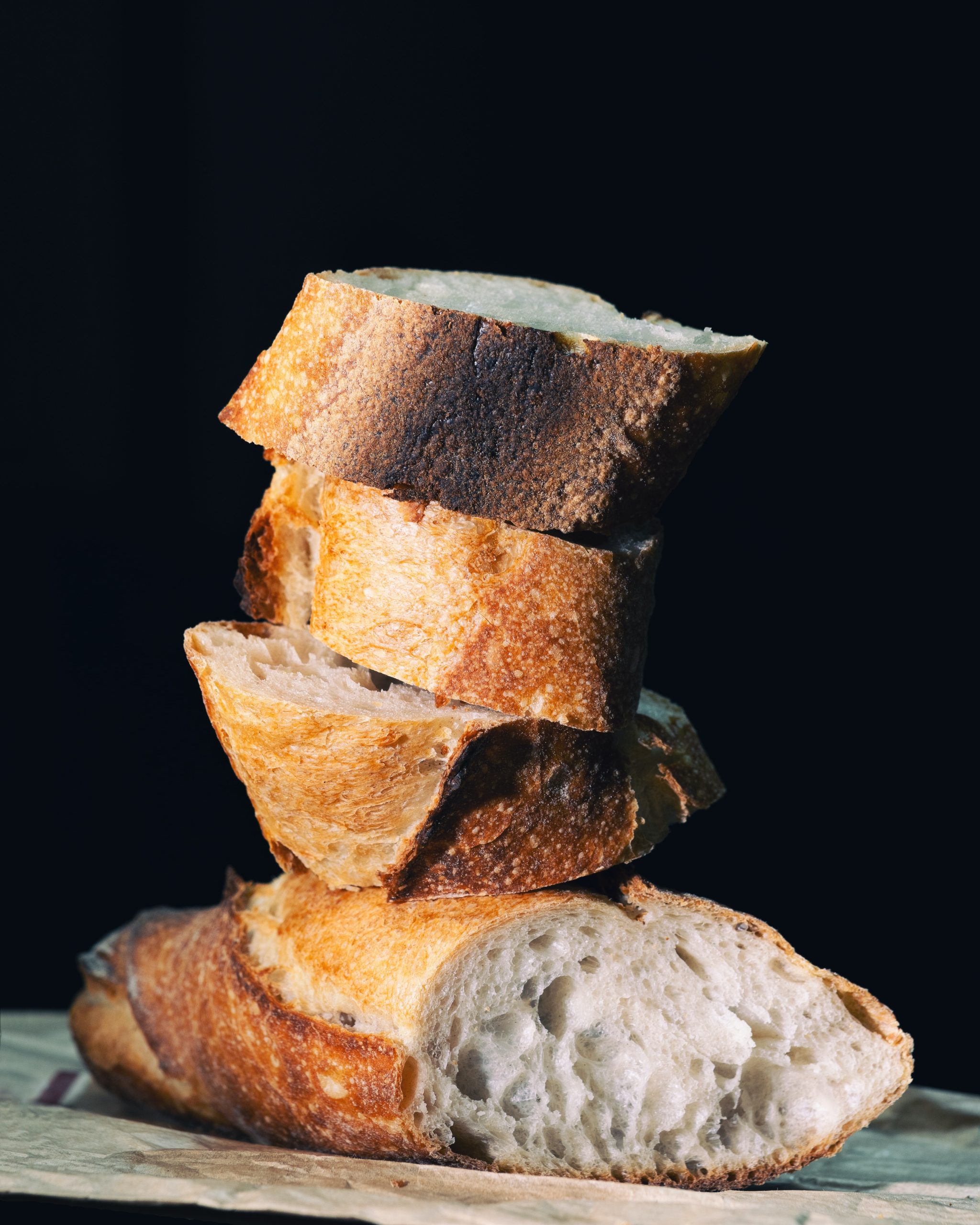By An Absolute Beginner
There is nothing better than a fresh baguette. And there is nothing worse than a long-winded description proceeding an internet recipe. So here are the facts, like many people staying at home during the pandemic, I decided to investigate the art of bread making. I’m a complete novice, and have absolutely no baking skills. This recipe is based on a combination of two youtube videos by experts John Kirkwood and Patrick Ryan, distilled down for the elementary baker. I highly recommend watching the videos, at least for the gorgeous accents. This is the perfect quarantine recipe, because it takes three days to complete and is best done when you don’t have anything pressing. That said, it is rather easy to make – I say as the completely NOVICE baker. I hope you enjoy. -A

French Style Baguette

There is nothing better than a fresh baguette. This recipe is based on a combination of two youtube videos by experts John Kirkwood and Patrick Ryan, distilled down for the elementary baker. This recipes requires a lot of time to rest, but it is worth it for the complex, developed flavor.
Pre-Fermented Dough
- 450 g Bread Flour
- 7 g Kosher Salt
- 300 mL water ((100 mL boiling, 200 mL cold))
- 2.5 g active dry yeast
Main Dough
- 500 g Bread Flour
- 10 g Kosher salt
- 300 mL water ((100 mL boiling, 200 mL cold))
- 5 g active dry yeast
Day 1: Time to Make the "Pre-Fermented" Dough
Measure out all the ingredients using the kitchen scale.
Combine the 100 mL boiling water and 200 mL cold water together in the 3.5 quart bowl.
Add the 2.5g active dry yeast and the 7g kosher salt to the water, and mix until combined.
Add the flour to the yeasted water mixture.
Use the handle of a wooden spoon to combine the ingredients.
At some point, you won’t be able to combine any more. Just flip the bowl contents onto the counter and use your hands and knead for three to four minutes.
To knead, use your palm to press into dough ball, and push away from your body. Then bring the outside edge of the dough (farthest from you) and fold it back towards your body. Repeat.
You don’t have to fully knead (like a typical dough). This will be a sticky, imperfect mess. You just want the dough to combine together.
Cover the dough with the Press’N’Seal wrap (or cling film, or even clean shower cap), and leave in the fridge for 18-36 hours.
The longer you can leave the dough, the better. Just don’t go over 36 hours.
Day 2: Time to Make the "Main" Dough
Measure out all the ingredients for the “Main Dough” using the kitchen scale.
Take the pre-fermented dough out of the fridge. It should have doubled in size.
Scrape the dough out of the dough, using hands or the bench scraper, and re-form into a ball. Cut the pre-fermented dough ball into small pieces.
This will make it easier to add to the main dough.
Combine the 100 mL boiling water and 200 mL cold water together in the 3.5 quart bowl.
Add the 5 g dry yeast and 10 g salt to the water and mix with whisk until combined.
Add the flour to the yeasted water mixture.
As the flour mixture is coming together, add the bits of the pre-fermented dough bits.
Once the mixture has roughly balled together, flip (or scrap) onto the clean counter.
Knead the dough for 8-10 minutes.
To tell if the dough is done, cut a smallish (210-260g) piece of dough and stretch out from the middle, like you’re forming a pizza. The center should allow some light through.
The dough will be very sticky. Do not add more flour or it will become very dense.
Place into a well oiled bowl, cover with cling wrap, and leave overnight* in the fridge.
* If you are really pressed for time, you can leave the dough to proof at room temperature for 2 hours. However, it’s best to leave the dough in the fridge overnight to develop the best flavor.
Day 3: Bread Baking Day!
Remove the dough from fridge and turn out onto a clean work surface.
Divide the dough into six equal balls, about 240-260g each, using the bench scrapper.
Try to get the dough bits as equal as possible.
Once the dough balls are cut, shape each of them into a ball, and let it rest for 5 minutes.
This will let the gluten within the dough relax and will help you when you’re shaping your dough.
While you're making the indiviudal dough balls, cover the rest of the dough with a tea towel to prevent a crust from forming.
Flatten each dough ball into a rectangle.
Take the two ends of the dough and slightly stretch the dough width wise out. Take the two “handles” and fold in. Then take the edge length-wise closest to you and fold in half. Roll the dough over to form a rectangular square.
See the ‘gif’ below of how Patrick Ryan turns the dough ball into a rectangular "pre-baguette" shape:

Repeat for all six dough balls. Once complete, let them rest for 10-15 minutes.
During this time, take a baking sheet cover with your couche (pillow case). Sprinkle some extra bread flour.
Then take the dough, and start to form into a baguette.
Step 1: Take 1 dough ball and fold in about a quarter of the way, away from you. Repeat three times, sealing off the edge.
Step 2: Roll the dough out.
See the gif below for a clear example off rolling out the baguette shape (John Kirkwood)

As you finish each baguette, place on the couche. Create folds with the cloth to separate each baguette.
This will allow the baguette to rise up and not out.
I recommend placing a well-oiled layer of cling film on top of the baguettes to prevent a crust from forming.
Leave the baguettes to prove for about 50 to 60 minutes. They should slightly increase in size.
Preheat the oven to 425°F or the highest setting
Fill the baking pan with boiling water.
Once the dough has risen, use the pizza peel (or your hands) to transfer the dough to a baking tray seem side down.
Use the razor to score the bread.
John Kirkwood made a great diagram below:

Place the baking tray with the baguette and the baking pan with boiling water into the oven.
Bake for 15-25 minutes
I personally set the timer in 6 minute intervals. Resist the temptation to open the oven and release the steam.
Remove the baguette when it’s golden brown.
If you are want to make extras for later, reduce baking by five minutes.
Serve warm and eat immediately.


Aheli is the founder of Aheli Wanders, a blog she started in 2007. In addition to blogging (& dreaming about food), she is the Director of Product Management for tech startup. Aheli has traveled to over 35 different countries, and what feels like a million different restaurants. She lives in Brooklyn, NY with her husband. She hopes to add “and dog” to her bio one day.





![Best 2 Player Games [Updated]](https://aheliwanders.com/wp-content/uploads/2025/01/Board-Games.png)

Leave a Reply to EmilyCancel reply